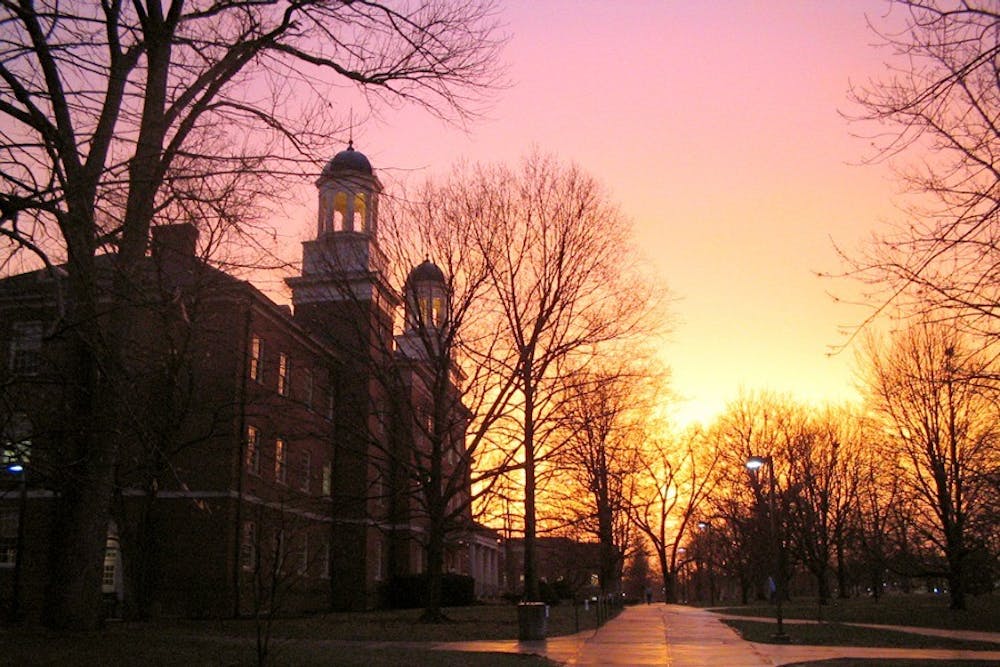Milam's Musings, milambc@miamioh.edu
There is no race problem at Miami University: one of the most homogenous public universities in the country. That is to say, most everyone on campus and in the classroom - more than 81 percent - will look like me: white.
There is no race problem at Miami University: where clear tensions exist between its white student body population and its slightly less than 10 percent international student body population. Last November's anonymous letter to the editor about admitting international students demonstrated that.
There is no race problem at Miami University: the university that ranks No. 9 in the Princeton Review's Little Race/Class Interaction list, which asks students, "Do different types of students (black/white, rich/poor) interact frequently and easily at your school?"
There is no race problem at Miami University: the university where, in 2010, the Alpha Xi Delta sorority was suspended for two years after deplorable behavior at the National Underground Railroad Freedom Center. According to the Cincinnati Enquirer, one partygoer was found trying to urinate on the 19th century Slave Pen exhibit.
There is no race problem at Miami University: where some alumni pine for the days when students and their mascot were Redskins instead of Redhawks.
There is no race problem at Miami University: where social media platforms like Facebook, Twitter, Yik Yak and the comment sections at The Miami Student are replete with reactionary, hold-to-tradition, thinly-veiled racism.
In response to Miami students standing with Mizzou, comments like, "Good idea - be more intentional - transfer to Missouri," receive nine likes on Facebook (the same commenter also wanted an analysis of the NAACP in response to an article on the KKK). Where comments like, "There's no evidence that three of the four incidents of racism actually happened [at Mizzou]," receive six likes.
Despite, you know, the evidence. Not only is there a picture of the poop swastika, but also a police report indicating its existence.
Despite other incidents unremarked upon, like the two white male students arrested at the end of February in 2010 for spreading cotton balls on the grounds in front of the Gaines/Oldham Black Culture Center at Mizzou. Or that the racial issues with black student athletes at Mizzou stretch back decades.
Then there are the anecdotes of racism, like Mizzou journalism professor Cynthia Frisby, who said she had been called the n-word too many times to count. She recounted in a widely shared Facebook incident after incident.
But people won't believe her. Just as they won't believe the other anecdotes from other black people about the racism they've encountered, including the recent letter to the editor in The Miami Student from Miami graduate Brandon Patterson.
Enjoy what you're reading?
Signup for our newsletter
That's nothing new, unfortunately. When encountering stories of racism, whites tend to turn a skeptical ear; black people must be lying or exaggerating or misinterpreting the situation, they say.
There just can't be any sort of race problem at Miami University; such would impinge upon the beautiful white bubble and "tradition."
The University of Missouri's new interim system president, Michael Middleton, said he felt marginalized every day because of his race when he was a student and now as an administrator.
Are we to discount that? Are we to say, 'nah, that can't be?'
"It's so subtle," he said. "I think women understand it. I think people with a sexual orientation [that is not straight] understand it. I think other people of color understand it ... it is just the feeling of not being heard, not being respected and being placed on the margins of what's happening in the world."
He's right. It's hard for white, heterosexual and often males, to consider the margins. White, masculine heterosexuality is the norm. I don't consider my whiteness because I don't have to. Our institutions and our people demand that black people think about their skin whenever they maneuver through society.
There were 565 undergraduate black students on the Oxford campus in 2013, the last year for which enrollment records are available on Miami's web site. Or, put another way, black students represent 3.6 percent of the student body population, far below the 13.4 percent of blacks in Ohio as of 2010.
Just consider what it would look like for you to sit inside a classroom and most of the people around you don't look anything like you?
It should come as no surprise, then, that according to the Higher Education Research Institute at UCLA, students at low-diversity institutions reported more instances of stereotyping, discrimination and harassment on campus at 22.7 percent. Most incidents go unreported, however.
One of the linchpins of the narrative that race is a yesteryear problem was the election of Barack Obama to the presidency. His election surely indicated the ushering in of a post-racial society, right?
Actually, according to the Department of Education, the number of racial complaints reported on college campuses has nearly doubled from 555 in 2009 to 939 in 2014.
While these numbers may not seem like a lot, although the increase is certainly worth noting, it's not as if there needs to be lynching in front of Bell Tower to constitute a need to confront racism on campus.
Higher education ought to be the place where we are challenged and encounter new ideas and new ways of thinking. At Miami, that's certainly possible in some respects, but with how overwhelmingly white and upper middle-class the student body population is, it's a self-protecting bubble.
Any cries of a problem, along race or class lines, is derided as either untrue or merely an isolated, non-representational example.
None of this has anything to do with being oversensitive, a social justice warrior or buying into the "increasing Marxism of college campuses."
There are absolutely valid concerns to be had about upholding free speech on college campuses or the worry over helicopter parenting and the coddling of students.
All of those discussions can and should be had. But the race discussion is one of those valid areas of concern.
I'm also more in favor of these discussions happening at the community level. We can't expect President Hodge to wave a magic wand and make minority students on campus feel welcome. We cannot and definitely should not expect MUPD to police hateful speech.
The problem with living in a bubble is that you're not aware of doing so and when someone threatens the integrity of the bubble, you react defensively. It does not have to be that way. Listen, engage and try to understand the experiences of people that aren't like you.
Maybe you, considerate reader, think it's unfair to extrapolate and then generalize from Yik Yak or some choice Facebook comments. There are more than 15,000 students, after all, right? It's true that it's hard to truly gauge what the racial climate is on Miami's campus, especially since the student body is often characterized as apathetic, but there are two things that are indisputable:
One, Miami is incredibly white - more so than comparably sized universities. Being so homogenous is inherently going to create blinders to different perspectives and experiences, i.e., the bubble.
Secondly, Patterson spoke in this publication about his experience on campus as a black man. It would be wrong to say he speaks for all black experiences on campus, as the black experience is not monolithic, but it was his experience. Other minority students have also spoken to similar feelings of being unwelcome or marginalized. We ignore that at our own peril.
A guest column in this paper by the Black Student Action Association titled, "Racism is alive and well at Miami," from Nov. 16, 1979, starts, "All too often, we 'contemporary' blacks tend to believe that racism is a thing of the past. We have been and are being told that racism is dead, with, of course, the exception of a few misguided souls still advocating it racially. We are told that they are inconsequential."
It's profound that 36 years later, almost to the date, we are still being told that racism is a thing of the past, that it is dead and that there are only a few misguided exceptions of inconsequential concern.
Miami, the credo "love and honor" demands that we can and ought to do better.




